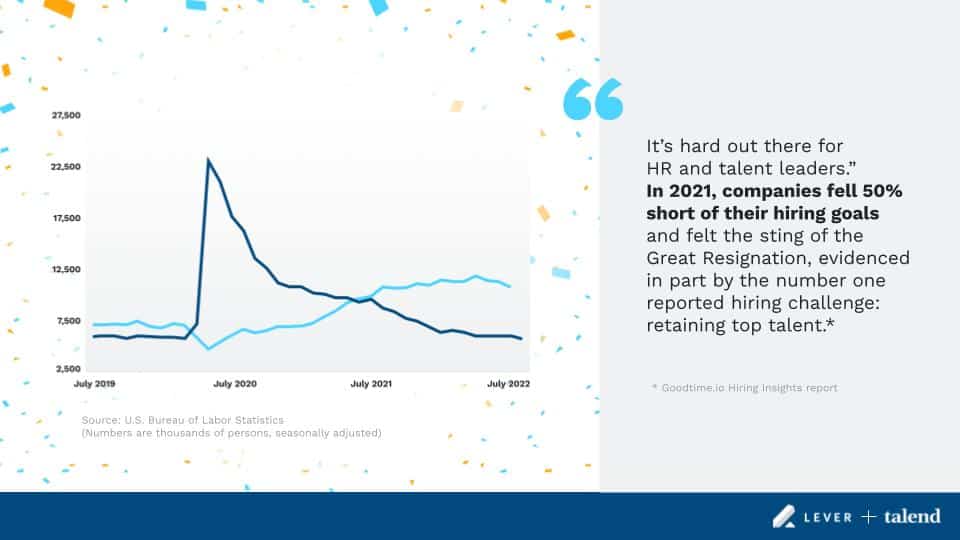The talent acquisition landscape remains difficult for companies across industries. All you have to do is look at recent hiring data to see how employers of all sizes have struggled with attracting — and keeping — top talent.
In 2021, U.S.-based companies fell short of their hiring goals by 50%. Companies also felt the sting of the Great Resignation, which only added to the challenge of retaining top talent.
In a recent HR Tech Conference conversation, Lever CEO and Cofounder Nate Smith sat down with Talent VP of Talent Acquisitions Lance Sapera to discuss data’s importance in improving TA teams’ recruiting and hiring processes.
Nate and Lance noted in their session that employers have access to more data than they know what to do with. But they said it’s vital for talent leaders and their teams to use data strategically to identify, engage, and ultimately hire the best talent.
Here are key takeaways from Nate and Lance’s insightful HR Tech Conference conversation that can help you plan your recruiting and hiring strategies for 2023.
1. Recruiting is harder than ever today
Recruiting is a challenge. The chart below shows how the 2019 labor market looks similar to our current market.
There are many reasons why it is hard to recruit:
- There is a skills gap in the workforce. There aren’t enough people with the right experience or education to fill open roles.
- Companies have lost trust in traditional recruiting methods because they don’t feel they’re getting the best talent or people who fit their company culture.
- Candidates want more than just a job; they want meaningful work and an opportunity to grow in their career — and companies need to be able to meet those needs if they want top talent on their teams.
2. Get started by sharing what you have
According to Lance, it’s crucial to share your data and spark cross-functional conversations. You’re already using data to make decisions in HR, but there’s a lot more you can do to connect with other departments.
Sharing and reviewing this data with other teams will give them a better picture of how their actions affect your department. What’s more, it helps uncover ways to improve the relationship between hiring managers and HR, which could increase employee retention rates.
If you’re not sure where to begin, here are some of the areas Lance recommended starting with:
- Time to Fill: Planning (FP&A & Business) Drive speed and urgency
- Candidate Experience: Personalized recruiting matters
- Nurtured Candidates: Reduced TTF Lever Case Study
3. Use data to be more proactive in recruiting processes
Recruiters should use data to be more proactive in recruiting processes. The importance of data analysis can’t be overstated when it comes to finding the right people and improving retention rates. Still, recruiters need to know what types of data they should collect, how they can use that information, and what steps they can take to get there.
According to Nate, data can be a tool to show how to move forward. One of the main benefits of data is that the CEO, down to the hiring manager, can go to Tableau to see metrics. This creates an opportunity where a hiring manager can see the results and understand if they’re finding great people for the role.
“According to a survey we conducted on LinkedIn, we found that 62% more people than not are using data to help make recruiting decisions.” – Nate Smith
In terms of talent acquisition, data can help tell a story about where the company is succeeding and where improvements can be made.
For example, if there is a high turnover rate in a particular department, that could be indicative of a problem with the way that department is run. And when leaders are armed with this data, they can make more informed decisions about how to improve individual performance, their teams, and identify opportunities for internal mobility.
“We’ve seen attrition, like a lot of companies increase. Why are we waiting around and interviewing external people when we’ve got a chance to retain a top performer, grow their career, and help the company?” Lance Sapera
4. Make data readily available to your organization
Employers should now have access to more data than they know what to do with. And that’s a good thing. Why? Because now they can make better, smarter business decisions.
In today’s business world, the ability to attract and retain top talent is more critical than ever. Therefore, organizations must have a robust talent acquisition (TA) strategy.
One key element of a successful TA strategy is the use of technology. By leveraging the right technology, TA teams can develop a centralized source of truth, build their tech stack, and analyze data in real-time.
According to Nate, implementing advanced analytics drives cross-functional buy-in and increases collaboration.
By taking these steps, your TA team will be better positioned to identify top talent, understand the latest market trends, and make data-driven decisions to help your organization attract and retain the best employees.
Reevaluate your HR tech stack to future-proof your recruiting and hiring
HR technology is a tool. It’s not the be-all and end-all of your hiring processes, but it can help improve your process. With all the new options available in HR tech, it can be hard to know where to start.
The truth is that employers have access to more data than they know what to do with, so it’s our responsibility in Talent Acquisition to use that data strategically.
Download the ATS Buyer’s guide to learn more about how to implement technology and find the right recruitment solution.
 Talent Relationship Management, Explained: A Guide for Recruiters
Talent Relationship Management, Explained: A Guide for Recruiters
 For the third quarter in a row, Lever has won two Comparably awards!
For the third quarter in a row, Lever has won two Comparably awards!

